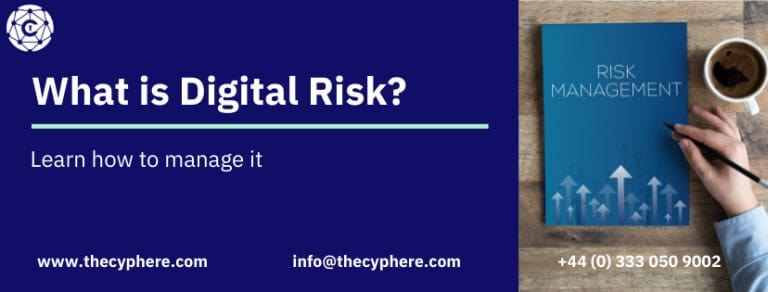
Digital risks are a big issue for today’s society. Digital risks can be anything from stealing sensitive information to exposing your own personal information to the public. This is why an understanding of the digital risk management process helps businesses to identify and protect themselves.
The truth is, a lot of these things can happen to you – even if you take precautions and try not to expose your private information to the public or use public computers to send confidential documents. We have seen many examples where people have been exploited online and had their entire life stolen from them. It’s important to understand how to manage digital risk is so you can protect yourself against it – read this guide for more information!
What is a digital risk?
Digital risk is an unwanted outcome that stems from the use of technology. Digital risk is a potential problem that might have an impact on an organization’s operations. It can be anything that has an influence on the company’s Internet presence, such as a website outage, information theft. Other threats may include data breaches, cybercrime, such as ransomware attacks or other digital threats such as social engineering attacks (spearphishing, voice phishing).
Cyber threats can arise in a number of ways – it’s up to you to understand how to protect yourself against them.
Different types of digital risk

Following are some common types of digital risk that companies face in the modern world:
Data leakage
Data leakage is a digital risk where sensitive data about your company, employees or customers ends up in the wrong hands. This can happen through hacking, malware and other threats.
A data leakage, or a data spill, is the accidental or unauthorised release of confidential, private, or sensitive data. This can include data that is stored on electronic devices such as computers and smartphones, as well as data that is transmitted over the Internet.
Cyberattacks
A cyberattack is an intentional attack on your digital infrastructure or data. This includes viruses, malware in the form of email or cyberattacks on Internet-facing infrastructure. Various types of attacks exist that can affect an organisation in a number of ways.
Third-party risks
These are general umbrella terms for all of the ways that a third-party risk can affect your business through digital risk. For example, by using a supplier with relaxed cyber security controls, you could be at risk of a cyberattack or data leakage due to this weak link in your supply chain.
Compliance violations
The digital world is changing continuously. Businesses need to adhere to certain regulatory and compliance requirements based on their industry or sector. Any digital risks exploited by cybercriminals could lead to loss of compliance such as PCI DSS, GDPR, CCPA, HIPAA, SOX or any relevant compliance.
Your business will need to adapt quickly in order to keep up with the changes or else you may face compliance risks. These could lead to a loss in revenue, fines or even a business ban.
Outage or downtime
Digital businesses are growing in number every day which means that your company needs a strong infrastructure if it is going to survive.
Security breaches
No matter, if you’re a small business or a large multinational, your company needs to be aware that it’s not safe from cyber attacks in the digital age – companies big and small are frequently targeted by cyberattacks.
Insider threats (internal)
Internal risks are security threats that can come from within your company. This could be an employee who accidentally sends out personal data to the wrong person or someone that is intentionally trying to steal data or access confidential documents.
How to mitigate a digital risk?

Once you’ve identified digital risk and the impact it could have on your company, you need to put a plan in place that will mitigate these threats. Here are some ways this can be done:
Strong authentication controls (including passwords)
Authentication is often the most talked-about domain within the cyber security space. Strong authentication controls including utilising strong passwords frequently are one way of ensuring that attackers cannot access your accounts – especially if they’re using malware or phishing!
Use multi-factor authentication as most of the applications, services and software provide this feature. If this is not possible, consider discussing your implementation changes with the vendors that provide 2MFA integration plugins. Make use of password managers, strong password policies, logging and auditing as mandatory practices.
Implement digital policies
Having strong digital policies in place can help to protect your business against cyber risks – especially third party risk or employees risk! It’s a good idea to have strong data protection and retention policies in place in order to protect your sensitive data. Some of the most popular policies in a workplace include anti-virus policy, access control policy, information security policy, sensitive data and data classification, configuration management policy, incident response policy, Personally Identifiable Information (PII) policy, fraud policy, remote access policy and risk management.
Update your digital security software
If you don’t update your security and anti-virus systems, risks could get past these defences – make sure that this doesn’t happen by regularly updating them.
Security devices, software and services are often targeted by cybercriminals for known and unknown weaknesses. It provides a gateway into a company’s digital infrastructure.
Run penetration tests regularly
It is important to run periodic penetration tests on the company’s digital infrastructure. At the least once annually or upon changes in infrastructure, it is important to know your weaknesses so you can improve continuously. This digital risk assessment is important because it will identify any security holes that are being exploited by cybercriminals.
Risk mitigation
Once you’ve identified risk and the impact it could have on your business, make sure that a risk assessment is carried out. This will help identify ways of mitigating these digital risks such as updating software or changing passwords frequently. Tactical risk mitigations will reduce your attack surface.
What is Digital Risk Management?
Digital risk management is the proactive identification, assessment, and management of risks to an organisation’s digital infrastructure. It includes the identification of threats and vulnerabilities, as well as the development and implementation of risk management plans.
It is a necessary investment by the business to minimise the potential risks to an acceptable level. Protecting your business from risks before they have an impact.

Digital risk management cycle
To understand how to deal with risks, you need to know about the risk managing cycle which goes like this:
Identify
Collect data about potential threats in order to determine which risk could affect your business. Identify all assets exposed to potential unauthorised access. This must include all social media channels and resources housing sensitive data.
Assess
Perform risk assessments throughout your infrastructure and determine how likely they are to occur. Some organisations may not find social media accounts to be of critical importance, but we continue to see these accounts targeted by different attackers.
Respond
Determine your response plan so you can protect yourself against digital risk when it occurs! Create risk and threat models, include every critical asset. This might be an incident or crisis management plan for cyberattacks, a data leak prevention strategy or whatever else is relevant in protecting your company from threats.
Prevent
Prevent attacks from occurring again by learning how to detect digital threats and using effective preventive controls.
Monitor
Monitor threats over time so you can stay on top of new security issues as they arise. This will help you determine whether your response plan needs updating or not, depending on what digital risk is currently affecting your digital infrastructure.
How can digital risk management help?
Managing digital risk allows businesses to identify the risks they face and protect themselves against digital threats. This process will help businesses protect their digital infrastructure and data while preventing negative events from taking place.
How to protect yourself against digital risks:
You can utilise a number of different strategies in order to prevent digital disruption from affecting your company. These include the implementation of digital security solutions, training for employees and more.
Take some time now to identify digital threats and you’ll soon be on top of any digital disruption. A company should scrutinise every asset added to the infrastructure for a possible increase in risk and expanded attack surface.
Best practices
We’ve outlined some essential security measures to aid you to keep your company’s IT infrastructure safe.
1. Risks need to be identified and assessed in order to determine whether they can actually take place or not. This involves identifying them, knowing when digital disruption could occur and how it might affect your business.
2. Risks can be monitored over time in order to determine whether they are likely to actually take place if response plans need updating and more.
3. digital disruption is best prevented rather than trying to fix it once it happens! This means using the risk management cycle so you always know about digital network threats before they occur.
4. digital response plans should then be put into place so you’re prepared for a cyberattack or data breach before anything happens. You can avoid digital disruptions if you prevent them from happening in the first place!
5. Managing risk is a continuous cycle that businesses need to implement in order to protect themselves against threats. Monitor digital disruptions over time so you can ensure your business stays safe from them!
6. Digital risks should be monitored overtime to make sure your response plan is up-to-date and relevant. This will help keep disruption at bay while protecting your infrastructure.
What is a risk matrix?
A digital risk matrix is a tool that helps organizations to identify, assess, and manage the risks associated with their use of digital technology. This risk matrix helps to determine what digital disruption might occur, how serious it could end up being and more.
A risk matrix can help you identify threats and risks that might occur in the future. This will allow you to implement a digital response plan so your business is prepared for any type of cyberattack or data breach.
Conclusion
As digital disruption becomes more common, it’s now essential for companies big and small to manage their cyber security. Managing digital risk is a great way for businesses to protect themselves against digital threats by staying aware of digital risks, preventing them from happening and more. It’s an ongoing process that should be implemented in order to make sure disruptions don’t affect you. If anything does happen, your business will have the right response plan ready so you can get back up and restore.
Shahrukh, is a passionate cyber security analyst and researcher who loves to write technical blogs on different cyber security topics. He holds a Masters degree in Information Security, an OSCP and has a strong technical skillset in offensive security.












